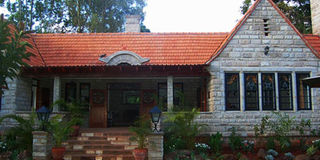TRAVEL: A slice of the past

Grogan Mcmillan manor house at Karen Blixen Coffee Garden. PHOTO| BONNIE DUNBAR
What you need to know:
Strolling around the garden on a cool morning, the wooden plank bridge over a brook adds old-world charm with the cottages and 100-year-old trees.
A pair of Hartlaub’s turaco with wings spread, add a vibrant scarlet. I’m in for another surprise – a house that I had seen many years ago on Chiromo campus.
It was Ewart Grogan’s house who, for the love of a woman – Gertrude – walked from Cape Town to Cairo from 1900 to 1902 and penned a book out of it.
If coffee had taken root in Nairobi’s lush Karen suburb 100 years ago, it might have looked very different from today, and maybe Karen Blixen’s life may well have been very different.
She could have lived on in Nairobi as a successful coffee farmer and never penned ‘Out of Africa’, which drew in large numbers of American and European tourists after Hollywood turned the novel into a movie in 1985.
As fate had it, Karen Blixen’s life turned out to be a tragi-romance. Sailing into Mombasa in January 1914, where she was married to Bror Blixen on the same day, the two arrived in Nairobi to start a new life. Bror Blixen had bought a huge coffee plantation in Karen (with Karen’s money) from the Swedo African Coffee Company in 1913.
The company built Swedo House around 1908, which was occupied by Blixen’s farm managers and her brother until she left in 1931, never to return. Her own house, Bogani (meaning house in the woods), built in 1912 and was a kilometre away from Swedo House. It is today the Karen Blixen museum.
Covering almost 4, 000 acres to the iconic Ngong Hills, the farm teemed with wildlife. But the land was never good for coffee – part of the reason why it was sold to an unsuspecting newcomer.
Bror Blixen’s skills as a farmer failed, the marriage floundered and despite Karen’s efforts to save the farm, it went bankrupt.
But Swedo House survived, hosting dignitaries such as Teddy Roosevelt, the American president, on his big game safaris.
Fast forward to the 1990s. Dr Bonnie Dunbar arrives in Kenya to work at the Institute for Primate Research (IPR). Driving past the decrepit building that’s called Swedo House aroused her curiosity.
RENOVATED
“Swedo House was so gone that it was almost collapsing on its stilts,” recalls the scientist. The stilts were reinforced with ballast; the floors, walls and ceiling cleaned or replaced and the rest of the garden beautifully landscaped with replicas of cottages complete with the tin-green mabati for guests to stay. Standing in the century-old house that’s been renovated to look like how it was, even the coloured window panes have been preserved.
“The area was commercially zoned and if I hadn’t bought the house, it would have been razed. I bought it to save the old house,” says Dunbar.
Strolling around the garden on a cool morning, the wooden plank bridge over a brook adds old-world charm with the cottages and 100-year-old trees.
A pair of Hartlaub’s turaco with wings spread, add a vibrant scarlet. I’m in for another surprise – a house that I had seen many years ago on Chiromo campus.
It was Ewart Grogan’s house who, for the love of a woman – Gertrude – walked from Cape Town to Cairo from 1900 to 1902 and penned a book out of it.
Grogan married Gertrude and the two made Kenya their home. In 1905, he built the lodge on a 70-acre parcel by the river which was sold to Sir Northrup Macmillan, an American millionaire, whose wife built Mcmillan’s library in his memory, a few years later.
Lady Macmillan left the house to her maid and friend, Louis Dekker, an African-American who bequeathed it to the East African Women’s League. Later, it was to be auctioned off, and at the auction, Jon Lee, an avid builder and art collector got to know about it and mentioned it to Dunbar.
Dunbar bought the lodge and commissioned Lee (Lee of the funeral house) to rebuild it on the grounds of Karen Blixen’s coffee garden. Within three months it was up for the opening night in 2007. It’s been renamed Grogan MacMillan Manor House.
The doors and glass are replicas. The original window panes are coloured and patterned with Grogan’s initials – ESG – for Ewart Grogan Scott – with the year inscribed on them. A pair of cats prowl on the roof – imitations of the ones from the original site.
Check in at Karen Blixen Coffee Garden Restaurant and Cottages
www.karenblixencoffeegarden.com on Karen Road. There’s tons to do – play golf at Karen Country Club, go horse-back riding, visit Karen Blixen Museum and if you’re a nature lover, a walk in Oloolua forest is a must. Or enjoy the garden and spa.
Gertrude’s Children’s Home was built by Grogan in memory of his wife. It is the only paediatric hospital in east and central Africa.




